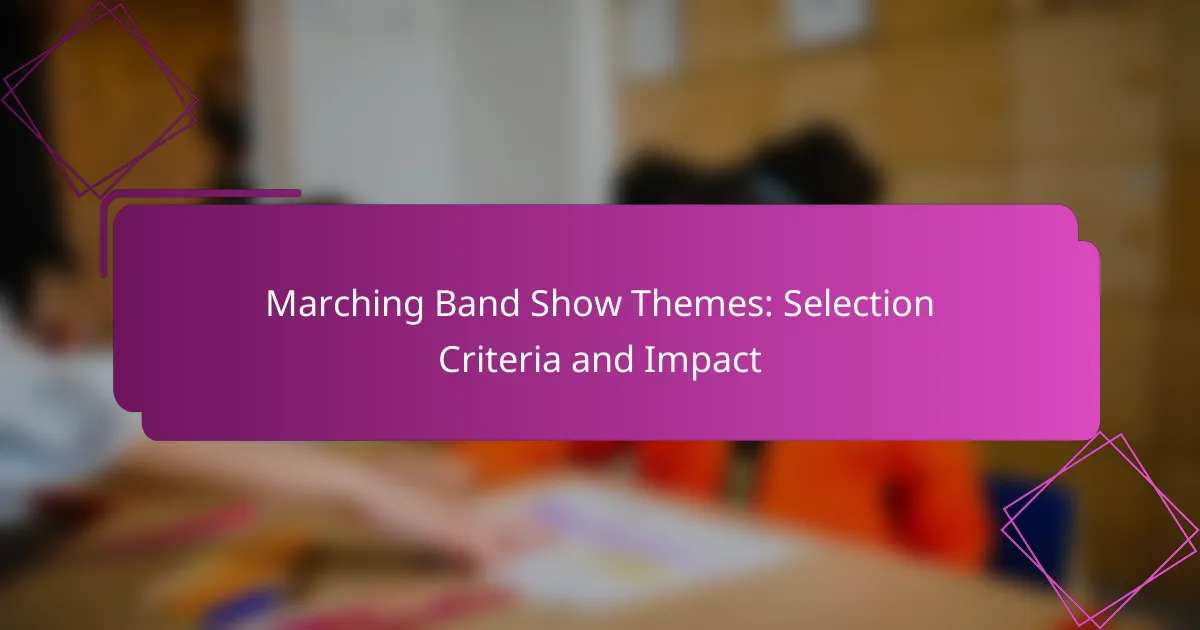Choosing an effective marching band show theme is crucial for creating an engaging and memorable performance. Themes should resonate emotionally with audiences and judges while highlighting the band’s musical and visual strengths. By considering factors such as audience engagement, musical complexity, and visual impact, bands can select themes that enhance their overall effectiveness and success in competitions.
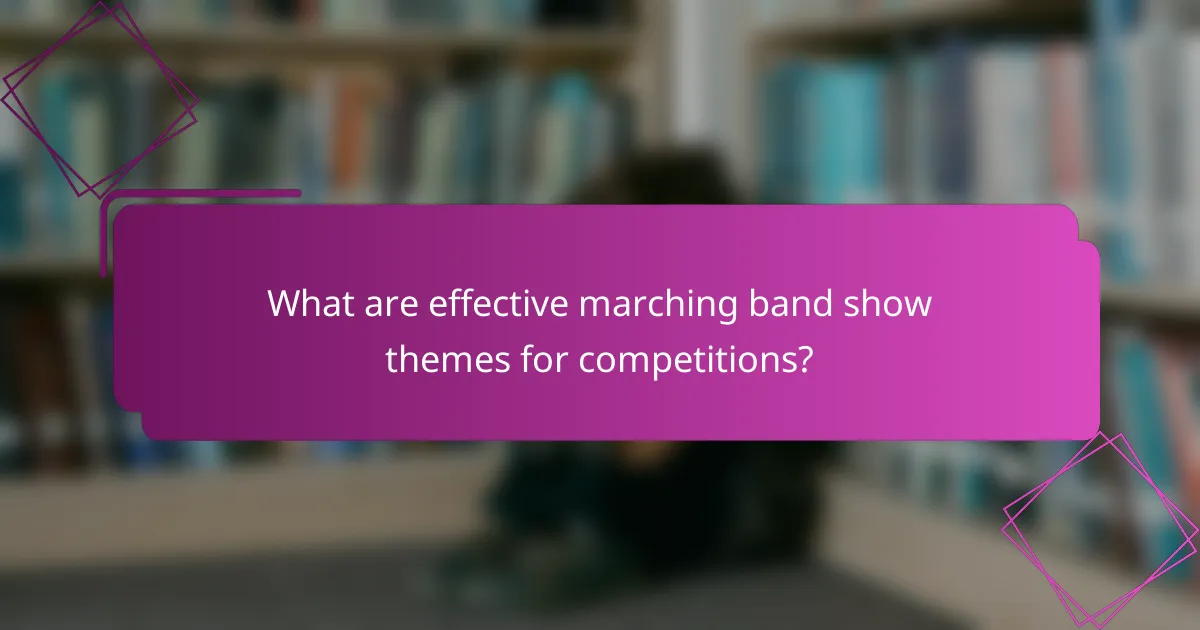
What are effective marching band show themes for competitions?
Effective marching band show themes for competitions are those that resonate emotionally with audiences and judges, while also showcasing the band’s musical and visual talents. Themes should be engaging, cohesive, and allow for creative interpretation through music, choreography, and visual design.
Classic literature adaptations
Classic literature adaptations provide a rich source of inspiration for marching band shows. Themes drawn from well-known novels or plays can evoke strong imagery and emotions, allowing bands to create compelling narratives. For instance, adaptations of works like “Moby Dick” or “Romeo and Juliet” can incorporate dramatic musical selections and visually striking formations.
When selecting a literary theme, consider the story’s core message and how it can be expressed through music and movement. Ensure that the chosen piece is recognizable to the audience, enhancing their connection to the performance.
Popular movie soundtracks
Popular movie soundtracks are effective themes because they tap into familiar cultural references, making them instantly relatable. Utilizing scores from beloved films can create an engaging atmosphere that captivates audiences. For example, soundtracks from movies like “Star Wars” or “The Lion King” can energize performances and encourage audience participation.
When choosing a movie theme, focus on iconic moments and melodies that can be easily translated into a marching band format. Consider the pacing and dynamics of the music to ensure a well-rounded performance that maintains audience interest throughout.
Historical events
Historical events can serve as powerful themes for marching band shows, allowing bands to tell stories of significance and impact. Themes based on events like the Civil Rights Movement or World War II can provide a platform for education and reflection, engaging audiences on a deeper level. Incorporating relevant music and visuals can enhance the emotional weight of the performance.
When selecting a historical theme, research the event thoroughly to ensure accurate representation. Aim to convey the essence of the event through both musical choices and visual storytelling, creating a cohesive narrative that resonates with viewers.
Modern artistic concepts
Modern artistic concepts can inspire innovative and visually stunning marching band shows. Themes based on contemporary art movements or abstract ideas allow for creative freedom in interpretation. For example, a theme inspired by cubism or surrealism can lead to unique formations and color schemes that stand out on the field.
When exploring modern artistic themes, encourage band members to think outside the box and experiment with unconventional ideas. This approach can result in a fresh and memorable performance that distinguishes the band from competitors.
Seasonal themes
Seasonal themes are effective for creating relatable and timely performances. Themes based on seasons like autumn, winter, spring, or summer can evoke specific emotions and visuals that resonate with audiences. For example, a fall-themed show might incorporate colors and music that reflect the changing leaves and harvest celebrations.
When developing a seasonal theme, consider the associated imagery and sounds that can enhance the performance. Use elements like costumes, props, and musical selections that align with the chosen season to create a cohesive and immersive experience for the audience.
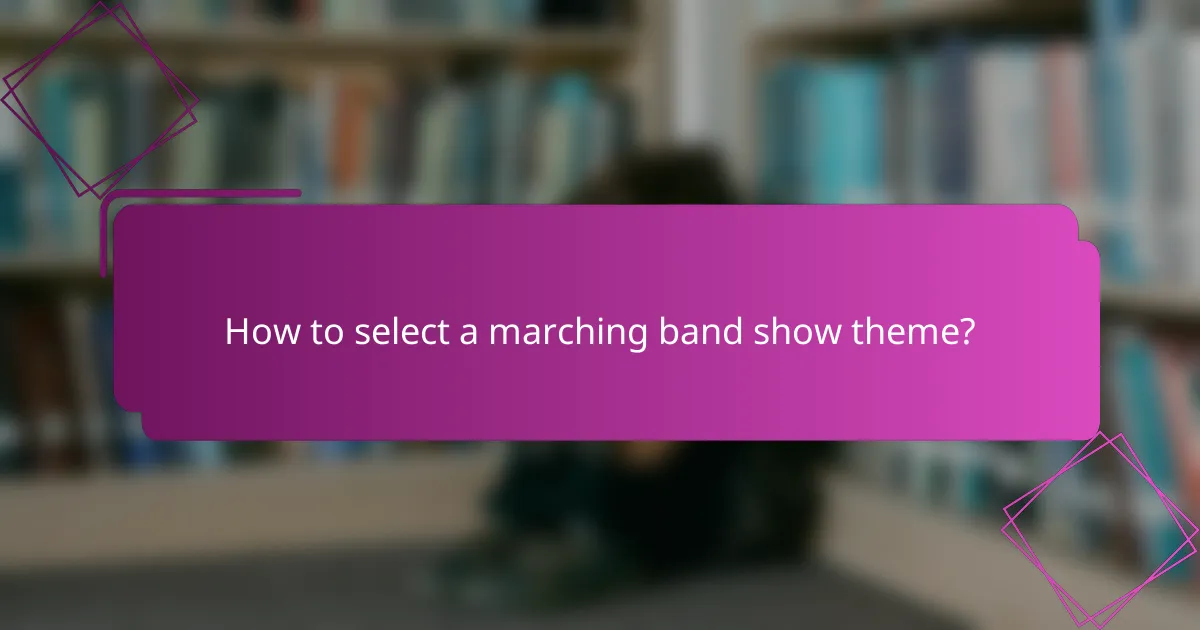
How to select a marching band show theme?
Selecting a marching band show theme involves considering various factors that enhance the performance’s appeal and effectiveness. Key criteria include audience engagement, musical complexity, visual impact, and alignment with the band’s strengths.
Consider audience engagement
Audience engagement is crucial for a successful marching band show theme. A theme that resonates with spectators can create a memorable experience and foster a connection between the performers and the audience.
To enhance engagement, consider themes that are relatable or evoke strong emotions. Popular culture references, historical events, or universal stories can captivate diverse audiences. For example, a theme based on a well-known movie or book can draw in viewers of all ages.
Evaluate musical complexity
Musical complexity plays a significant role in selecting a marching band show theme. The chosen theme should allow for a variety of musical arrangements that challenge the musicians while remaining accessible to the audience.
When evaluating complexity, consider the skill level of the band members. A theme that incorporates intricate rhythms and harmonies may suit an advanced group, while a simpler theme may be better for beginners. Aim for a balance that showcases the band’s talent without overwhelming them.
Assess visual impact
The visual impact of a marching band show theme is essential for creating an engaging performance. This includes the use of color, costumes, props, and formations that complement the musical elements.
Consider how the visual aspects will enhance the overall theme. For instance, a show themed around nature might incorporate green and brown costumes with props like trees or flowers. Strong visuals can help convey the theme and keep the audience’s attention throughout the performance.
Align with band strengths
Aligning the show theme with the band’s strengths ensures a more cohesive and confident performance. Understanding the unique abilities of the band members can guide theme selection and arrangement choices.
For example, if the band excels in brass instrumentation, a theme that highlights brass-heavy compositions may be ideal. Additionally, consider the strengths of the color guard and percussion sections, as their contributions can significantly enhance the overall presentation.

What is the impact of show themes on performance?
Show themes significantly influence marching band performances by shaping the emotional narrative and enhancing engagement. A well-chosen theme can create a memorable experience for both performers and audiences, ultimately affecting the overall success of the show.
Enhances audience connection
A compelling show theme fosters a deeper connection with the audience by evoking emotions and telling a story. When the theme resonates with viewers, it can lead to increased applause and enthusiasm, enhancing the overall atmosphere of the performance.
For example, themes based on popular movies or historical events often draw in audiences who can relate to the narrative, making the performance more impactful. Engaging visuals and music that align with the theme can further strengthen this connection.
Improves overall band cohesion
Choosing a cohesive show theme helps unify the band members, creating a shared vision and purpose. When everyone understands and embraces the theme, it promotes teamwork and synchronization during rehearsals and performances.
Additionally, a strong theme can guide decisions on choreography, music selection, and costumes, ensuring that all elements of the show work together harmoniously. This alignment can lead to a more polished and professional presentation.
Influences judges’ scoring
Judges often consider the effectiveness of a show theme when evaluating performances, as it can impact their scoring criteria. A well-executed theme that enhances musicality and visual appeal can lead to higher scores in competitions.
To maximize scoring potential, bands should ensure that their theme is clearly communicated through music, movement, and visual design. Consistency in theme representation across all aspects of the performance is crucial for impressing judges and achieving favorable results.
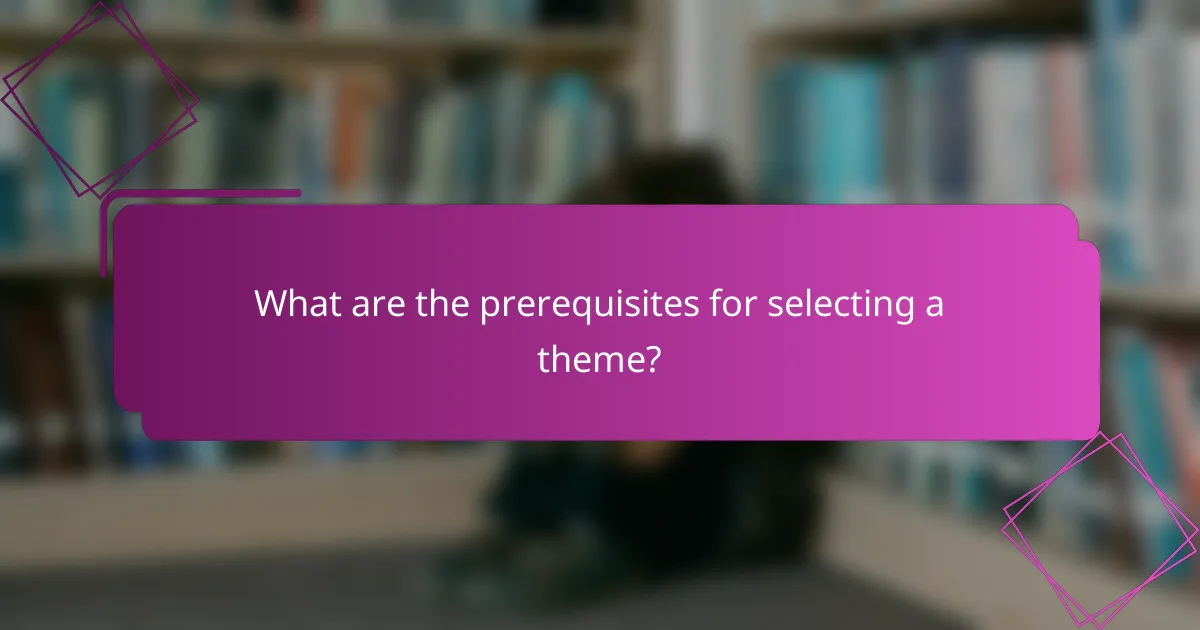
What are the prerequisites for selecting a theme?
Choosing a theme for a marching band show requires careful consideration of several key factors, including the band’s strengths, the competitive environment, and the audience’s expectations. A well-selected theme can enhance performance quality and audience engagement.
Understanding band capabilities
Assessing the band’s capabilities is crucial when selecting a theme. Consider the skill levels of the musicians, the instrumentation available, and the visual performance skills of the members. For example, a band with strong brass players may benefit from a theme that highlights powerful, bold music.
Additionally, evaluate the physical capabilities of the band members. If the group excels in intricate formations, a theme that allows for complex choreography can be advantageous. Conversely, if the band is less experienced, a simpler theme may be more appropriate to ensure a polished performance.
Researching competitive landscape
Understanding the competitive landscape is essential for selecting a theme that stands out. Analyze recent performances from other bands in your category to identify popular themes and trends. This can help you avoid clichés and find a unique angle that resonates with judges and audiences alike.
Consider the scoring criteria used in competitions, as certain themes may align better with judges’ preferences. For instance, themes that incorporate storytelling or strong emotional elements often score higher. Researching past winners can provide insights into successful thematic choices that have impressed judges.
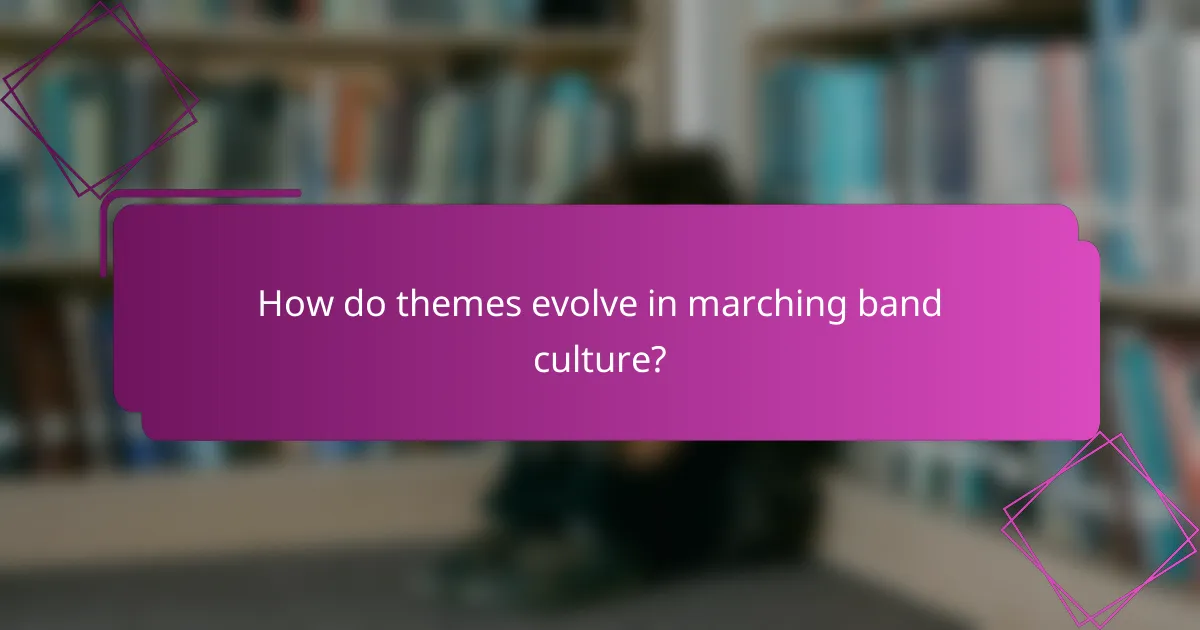
How do themes evolve in marching band culture?
Themes in marching band culture evolve through a combination of artistic expression, audience engagement, and trends in music and performance. As bands seek to captivate audiences, they adapt their themes to reflect contemporary issues, popular culture, and musical styles.
Trends in popular music
Trends in popular music significantly influence the themes chosen by marching bands. Bands often incorporate current hits or genres that resonate with their audience, such as pop, rock, or hip-hop, to create a relatable experience. This connection to popular music can enhance audience engagement and make performances more memorable.
For example, a marching band might choose a theme based on a popular movie soundtrack or a trending artist, which can draw in fans of that music. Additionally, themes that reflect social movements or cultural phenomena can resonate deeply, allowing bands to make statements while entertaining.
When selecting a theme based on popular music, consider the demographic of your audience and the relevance of the music to your performance goals. Avoid overly niche selections that may alienate viewers, and aim for themes that can appeal to a broad range of spectators.
